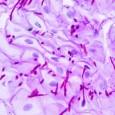Chlamydia is a common sexually transmitted infection. It is caused by a particular type of bacteria called chlamydia trachomatis. These bacteria can be passed through contact with bodily fluids of another person, especially during sexual contact including oral, anal, and vaginal sexual contact.
Since chlamydia is so easily passed on through sexual partners, it is one of the most common types of sexually transmitted diseases around the world. In the United States, it is estimated that nearly 3 million cases of chlamydia go undiagnosed each year. And approximately 1 million cases of chlamydia are estimated to be diagnosed in the United States every year.
Another reason why it is so common and so undiagnosed is that most people do not realize they have it, since many people experience no signs or symptoms of the infection at all. The infection can affect both men and women, no matter their age. However, it is diagnosed most commonly in younger, sexually active women. Since the infection can go undiagnosed, it can lead to more serious health issues. So it is important to get tested and treated if you suspect that you might have it.
Disclaimer: condom-sizes.org is supported by its readers. When you buy through links on our site, we may earn an affiliate commission. Learn more.
Furthermore, the bacteria that cause chlamydia can also be transmitted from mother to child via the birth canal. In infected mothers, the infection can cause serious complications during childbirth, including infant eye infections and possibly life-threatening pneumonia. For pregnant mothers, it’s important to get tested for the infection and be properly treated in order to avoid this complication.
Some typical risk factors for chlamydia include being under the age of twenty-five, having had sex with multiple partners within the last year, inconsistent use of condoms, or a history of contracting other sexually transmitted diseases. If you fall into any of these categories, you may want to get tested for chlamydia.
Chlamydia Symptoms
While the majority of men and women who have chlamydia do not ever have any signs or symptoms of the infection, when symptoms do occur, they will generally appear within one to three weeks of contracting the infection from an infected person. The incubation period for the infection, which is the time between exposure to the infection and any symptoms appearing, can be a few days to a few months. Men and women will typically have different symptoms of chlamydia.
For men, common chlamydia symptoms include tender scrotum, tender anus, crusting on the tip of the penis, cloudy urine, slimy or watery penile discharge, eye infections, and anal discharge.
The first sign of the infection in men will typically be an itching sensation during urination or pain during urination.
For women, common chlamydia symptoms will include abnormal vaginal discharge, abnormal vaginal bleeding, bleeding between menstrual periods, painful urination, cloudy urine, vaginal and genital area itching, lower abdominal pain, anal discharge, painful intercourse, eye infections, fever, fatigue, and swollen or painful glands around the vaginal opening.
Chlamydia Complications and Dangers
Chlamydia infections can have other complications. Many people who have chlamydia engage in sexual behavior which also risks being infected by other sexually transmitted diseases, including HIV and gonorrhea.
For women who have chlamydia, they may be at higher risk of having other infections including pelvic inflammatory disease or PID. This disease is an infection of the fallopian tubes and uterus. Severe infections of these organs can be serious and require hospitalization for treatment with IV antibiotics. In addition, this disease can cause damage to sexual organs including the cervix, uterus, fallopian tubes, and ovaries.
In men, chlamydia can cause the tube behind the testicles to become inflamed. This infection is called epididymitis and it can cause pain, swelling, and fever.
In addition, chlamydia can cause an infection of the prostate glands, also called prostatitis. This infection can cause lower back pain, painful urination, fever, chills, and pain after or during sex.
For women, chlamydia can also cause infertility as it can result in the obstruction and scarring of the fallopian tubes.
Another complication from chlamydia is a form of arthritis called reactive arthritis. It is also known as Reiter’s syndrome. The condition can affect the joints, as well as the eyes, and the urethra.
Diagnosis and Testing
Testing is recommended every three months for anyone who engages in high-risk behavior or has any risk factors for contracting chlamydia. Tests are recommended if you experience any of the signs or symptoms of chlamydia or if you engage in behavior which may have resulted in exposure to a sexually transmitted disease.
Tests used to diagnose chlamydia are quite simple. Your doctor may take a swab of the discharge from your genitalia. The swab will then be used to create a culture or antigen that will be tested for the bacteria. For women, this culture can be taken during a routine pap smear.
Urine testing is also available to diagnose chlamydia. The urine can be analyzed by a laboratory for the bacteria.
The most convenient thing is to order a home test – click here to order yours!
Treatment for Chlamydia
Treatment for chlamydia includes antibiotics. Many people may only require a single dose of antibiotics, while others may require a course of antibiotics which are designed to kill the infection.
The good news is that chlamydia can be treated and cured by antibiotics, often within just a week or two of being diagnosed and treated. During treatment, it is critical to avoid sexual contact. Any sexual partners you may have had will also likely need to be treated, even if they do not display any signs or symptoms.
After you are treated for chlamydia, it is critical to avoid any high-risk behavior. If a person continues to have sex with infected partners, it is likely they will be re-infected and need to go through diagnosis and treatment once again. It is important to note that being treated offers no protection or immunity from being infected again in the future.
Reducing Your Risk
As previously mentioned, the only 100% effective way to protect you from any type of sexually transmitted disease is to practice total abstinence. All types of sexual contact including vaginal, anal, and oral can put you at risk for contracting an STD.
However, if you are sexually active and want to reduce your risk, there are things you can do. First, try to practice monogamy. If you know your partner well and know that they are free from STDs, then your risk will be low. In addition, using condoms correctly and consistently has been shown to effectively reduce the risk of contracting sexually transmitted diseases.





